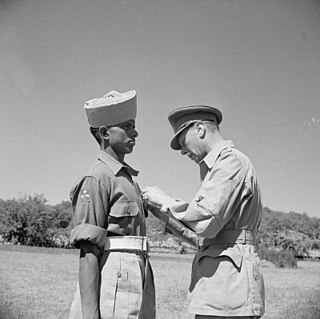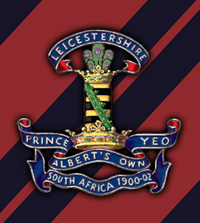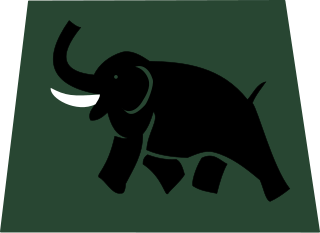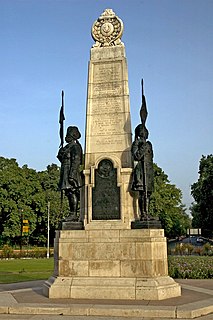George Shipway was a British author best known for his historical novels, but he also tried his hand at political satire in his book The Chilian Club.
Lieutenant Colonel John Masters, DSO, OBE was a British novelist and regular officer of the Indian Army.

Kamal Ram, VC was an Indian recipient of the Victoria Cross, the highest and most prestigious award for gallantry in the face of the enemy that can be awarded to British and Commonwealth forces. He was the second-youngest Indian recipient of the award. He was from the Gurjar community.

Bhowani Junction is a 1954 novel by John Masters, which was the basis of a 1956 film starring Ava Gardner and Stewart Granger. It is set amidst the turbulence of the British withdrawal from India. It is notable for its portrayal of the Eurasian (Anglo-Indian) community, who were caught in their loyalties between the departing British and the majority Indian population. The Anglo-Indian characters in the novel, like many members of their community, are closely involved with the Indian railway system.

Nightrunners of Bengal is the title of the first novel by John Masters. It is a work of historical fiction set against the background of the Indian Rebellion of 1857. It was published in 1951 in the United Kingdom by Michael Joseph, London, and in the United States by the Viking Press, New York.

4th Horse is a part of the Armoured Corps of the Indian Army, which had its beginnings as an irregular cavalry regiment during the time of the Indian Rebellion of 1857.

The Leicestershire Yeomanry was a yeomanry regiment of the British Army, first raised in 1794 and again in 1803, which provided cavalry and mounted infantry in the Second Boer War and the First World War and provided two field artillery regiments of the Royal Artillery in the Second World War, before being amalgamated with the Derbyshire Yeomanry to form the Leicestershire and Derbyshire Yeomanry in 1957. The regiment's lineage is currently perpetuated by E Squadron of the Royal Yeomanry.

The 2nd Lancers is one of the oldest and a highly decorated armoured regiment of the Indian Army. The regiment was formed by the amalgamation of two of the oldest regiments of the Bengal Army – the 2nd Royal Lancers and the 4th Cavalry.

The 5th Horse is an armoured regiment of the Pakistan Army. It was previously known as the 5th King Edward's Own Probyn's Horse, which was a regular cavalry regiment of the British Indian Army. It was formed in 1921 by the amalgamation of the 11th King Edward's Own Lancers and the 12th Cavalry.

The 6th Lancers is an armoured regiment of the Pakistan Army. Previously, it was known as the 6th Duke of Connaught's Own Lancers , and was a regular cavalry regiment in the British Indian Army. It was formed in 1921 by amalgamation of the 13th Duke of Connaught's Lancers and the 16th Cavalry. The regiment and its predecessors have seen active service on the North West Frontier, in Egypt during 1882, in China during the Boxer Rebellion, the two World Wars and the Indo-Pakistani War of 1965. On the Partition of India in 1947, the regiment was allotted to the Pakistan Army, where it remains in service today.

The 8th Light Cavalry traces its origins from the 8th King George's Own Light Cavalry which was formed in 1922 by the amalgamation of the 26th King George's Own Light Cavalry and the 30th Lancers following a re-organisation of the Indian Cavalry Corps. Both regiments were regular cavalry units that had had long and distinguished records in the British Indian Army prior to their amalgamation. During World War II the regiment was converted into an armoured car unit and served during the Burma campaign. After India gained Independence the regiment was named 8th Light Cavalry.The regiment is the third oldest armoured regiment in India and is amongst the most highly decorated regiments in the country.

The 31st Indian Armoured Division was an armoured division of the Indian Army during World War II, formed in 1940, originally as the 1st Indian Armoured Division; it consisted of units of the British Army and the British Indian Army. When it was raised, it consisted of two Armoured Brigades and one Motor Brigade.

The Imperial Service Troops were forces raised by the princely states of the British Indian Empire. These troops were available for service alongside the Indian Army when such service was requested by the British government. At the beginning of the 20th century, their total numbers were about 18,000 men.

Major-General Robert Harley Wordsworth CB, CBE was a British Indian Army officer and an Australian politician.

The 61st Cavalry Regiment is a horse-mounted cavalry unit of the Indian Army. It is notable for being one of the largest, and also one of the last, operational unmechanised horse-mounted cavalry units in the world. Formerly deployed into active conflict, 61st Cavalry is currently employed on ceremonial occasions, though it can be deployed for internal security or police purposes if required. On Republic Day each year the 61st Cavalry and the President's Bodyguard parade in full dress uniform in New Delhi, in what is probably the largest assemblage of traditional cavalry still to be seen in the world.

The 13th Lancers is an armoured regiment of Pakistan Army. It was formed in 1923 as 13th Duke of Connaught's Own Lancers by the amalgamation of 31st Duke of Connaught's Own Lancers and 32nd Lancers. On Partition of India in 1947, the regiment was allotted to Pakistan.

The 15th Cavalry Brigade was a brigade-sized formation that served alongside British Empire forces in the Sinai and Palestine Campaign, during World War I. Originally called the Imperial Service Cavalry Brigade it was formed from Imperial Service Troops provided by the Indian Princely States of Jodhpur, Hyderabad, Mysore, Patiala and Alwar which each provided a regiment of lancers. A maximum of three regiments served in the brigade at any one time. The states of Kashmir, Idar and Kathiawar provided smaller detachments for the brigade, which was at times reinforced by other British Empire regiments and artillery batteries when on operations.

The British cavalry were the first British Army units to see action during the First World War. Captain Hornby of the 4th Dragoon Guards is reputed to have been the first British soldier to kill a German soldier, using his sword, and Corporal Edward Thomas of the same regiment is reputed to have fired the first British shot shortly after 06:30 on 22 August 1914, near the Belgian village of Casteau. The following Battle of Mons was the first engagement fought by British soldiers in Western Europe since the Battle of Waterloo, ninety-nine years earlier. In the first year of the war in France nine cavalry brigades were formed for three British cavalry divisions. Other regiments served in six brigades of the two British Indian Army cavalry divisions that were formed for service on the Western Front. Three regiments also fought in the campaign in Mesopotamia, the only other theatre of the First World War where British cavalry served.
The New Year Honours 1915 were appointments by King George V to various orders and honours to reward and highlight good works by members of the British Empire. They were announced on 1 January 1915.
Charles Pocklington Chenevix Trench was a British Indian army officer, popular historian and writer.
















